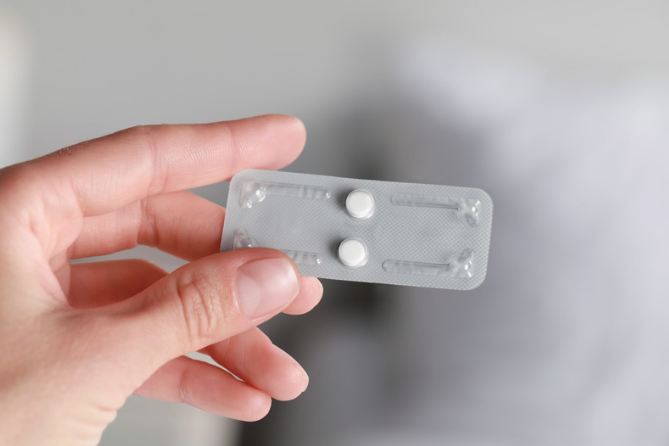
Fast-Tracked: The Facts Behind Chemical Abortion
How a relatively untested drug was invented overseas and later approved in the U.S. despite no initial trials stateside, no information on drug interactions and no information on long term effects, even today.
By Lisa Murtha
54% of all U.S. abortions in 2021 were chemically induced, owing to the approval 24 years ago of the drug RU486, or mifepristone. The drug was originally approved for in-person appointments at clinics for women who are up to seven weeks pregnant. This was extended to ten weeks gestation in 2016. In 2021 the FDA decided to lift the in-person requirement to obtain chemical abortion pills.
As the US Supreme Court readies for the March 26th hearings on the regulation of chemical abortions, both the Biden administration and the manufacturers of the drug are asking for the pill to remain available through mail order, as well – without a doctor’s examination – and for women up to ten weeks pregnant to have access to this type of abortion.
What many people call the “abortion pill” is actually a two-drug procedure. The first pill, mifepristone, is available only by prescription and was developed solely to abort babies by suppressing production of the hormone progesterone in a woman’s body (progesterone supports a pregnancy early on and is also later produced by the placenta throughout a healthy pregnancy).
Because the mifepristone is not 100% “successful” at aborting babies, the chemical abortion process involves a second drug, misoprostol (prostaglandin), which is administered two days later as both a sort of “back up” and a means of inducing contractions to force / expel a child from the uterus.
Though synthetic prostaglandins are common drugs used in treating conditions like glaucoma and stomach ulcers (and in inducing labor), RU486, or mifepristone was created solely to induce abortions. It was initially introduced for testing here in the U.S. early in President Bill Clinton’s first term (circa 1993) and received final approval for use in this country seven years later, just before the end of President Clinton’s second term, in late 2000.
Even before its arrival in the U.S., RU486 was denounced by the global pro-life community, which had waged a years-long opposition to the pill’s existence. As author R. Alta Charo notes in A Political History of RU-486, a 1989 statement by a Vatican spokesperson summed up opposition to chemical abortion best. “Let’s have the courage to say so openly; a way of killing with no risk for the assassin has finally been found.”
Where did mifepristone come from?
The pill itself is comprised of one active ingredient (mifepristone) and, like virtually every other prescription drug on the market today, five inactive ingredients or additives: colloidal silicon dioxide (an anti-caking agent use din medicines and salts but also used to thicken paint, dye and makeup), corn starch, povidone (a polymer used in eye drops, soaps and adhesives which has been banned for use in intravenous drugs), microcrystalline cellulose (wood pulp also used in processed foods) and magnesium stearate (a lubricant used in food, makeup and drugs that some believe suppresses the immune system).
The French biochemist / endocrinologist Etienne-Emile Baulieu, known colloquially as “the Father of the abortion pill,” is credited with coming up with the progesterone-blocking concept behind RU486 / mifepristone (without progesterone, a woman’s body cannot support a growing fetus and will ultimately push it out via contractions). The pill’s name, RU-486, was named at least in part for the French pharmaceutical company that first manufactured it – Roussel Uclaf.
Per Breitbart contributor and Controligarchs author Seamus Bruner, the drug was first brought to the US by a German pharmaceutical company, Hoechst AG, “in partnership with the Rockefeller Foundation’s Population Council,” a population-control-oriented nonprofit founded in 1952 by John D. Rockefeller III. Per Brittanica.com, the organization’s current stated mission is “to contribute to an equitable and sustainable balance between the needs of the world’s population and available resources.” Also crucial to note is that Hoechst itself had a significant history in the “population control,” or eugenics, movement as well, because its “ancestor company,” I.G. Farben, “manufactured cyanide gas for [Nazi] death camps,” per writer Steven Greenhouse in a 1989 New York Times Magazine piece.
Eventually, Hoechst, which initially refused to bring the drug to the U.S. for fear of international boycotts, donated patent rights for RU486 to the Rockefeller Foundation’s Population Council, who in turn worked with President Clinton’s administration and the FDA to bring the drug to market. The group subsequently licensed patent rights for the drug to Danco Laboratories, a for-profit Cayman- Islands-based company whose investors included George Soros & Warren Buffet, among other billionaires, and which allied itself with pro-abortion groups including Planned Parenthood, claims Breitbart’s Bruner.
That said, the drug (now marketed by Danco as Mifeprex) did not withstand the usual rigor of testing Americans expect from the FDA because it was approved under a Federal Code that was originally designed to fast track HIV medications to market, says National Right to Life’s website. As written, drugs approved under this Code are supposed to be for treatment of “serious or life-threatening illnesses.” In an effort to make the drug fit the legislation, the FDA officially reclassified “termination of an unwanted pregnancy” as a “serious condition,” says National Right to Life, so that it could apply the fast-track standard to mifepristone.
Another byproduct of the fast-tracking was the FDA’s ability to use data from another country in place of U.S. trial data in order to facilitate U.S. adoption of the drug. In fact, mifepristone’s initial approval was not based on U.S. testing at all, and instead relied on data from France, where the drug had been in trials since 1983 and was officially approved in 1988.
In an interesting move that seems an eerie predecessor to the MRNA/ Covid “vaccine” playbook, the data RU486 proponents used to fast-track approval of the drug was taken from French women who used an abortion pill manufactured in France. But the pill that was targeted for use in the U.S., says National Right to Life, was manufactured in China. Though they were both “very similar,” a representative of the French RU486 manufacturer noted in 1998, the two drugs were, in fact, different.
In addition, Hualian, the Chinese company that originally manufactured the U.S. market drug (and may still be manufacturing it) had been cited for multiple drug import violations already, says nrlc.org: “In 1998, a study by the California Department of Health Services found high levels of contaminants in an herbal medication made by Hualian’s earlier incarnation, the Shanghai No. 12 Pharmacy Factory, known as composite tegafuri capsules, as well as high contamination levels in hundreds of similar products made at the same plant. (219) Another drug (betamethasone) produced by Hualian was detained by FDA officials in Cincinnati in July of 2000 because of false or misleading labeling. This was during a time when the Chinese plant was undergoing an FDA re-inspection associated with the production of RU486, though inspectors there were not informed of the problem with the betamethasone intercepted in Cincinnati.”
Although Danco was the sole US-based provider of mifepristone for its initial two decades here, two other companies have since been approved by the FDA to sell it – GenBioPro and Corcept Therapies, which markets a newer, different version of the drug for alleged use in treating patients with a hormonal disorder called Cushing’s Syndrome.
“Both Danco and GenBioPro withhold general information about their companies from the public,” notes an article on ABCNews.com, “including the names of officials, where its facilities are located or production estimates.”
In addition, the article says, “Danco will only disclose that the company’s headquarters is located in New York City, while the drug itself is produced out of facilities in Europe that are inspected by U.S. federal officials.”
Side Effects

Most side effects listed in the FDA-approved leaflet for mifepristone are largely benign (nausea, cramps, normal amounts of bleeding associated with a period or miscarriage), but both the French and later US trials included numerous women who ended up in the emergency room and two women who suffered near life-threatening cases of blood loss.
Also per the leaflet, “According to data from the U.S. and French trials, women should expect to experience bleeding or spotting for an average of nine to 16 days, while up to 8% of all subjects may experience some type of bleeding for 30 days or more. Bleeding was reported to last for 69 days in one patient in the French trials. In general, the duration of bleeding and spotting increased as the duration of the pregnancy increased.”
In addition, the Des Moines Register noted in September 1995 that “One Iowa woman participating in the U.S. trials lost between one half and two-thirds of her total blood volume and probably would have died if she had not had emergency surgery.”
Information currently available online shows that mifepristone was eventually tested on 827women in the US, but the majority of the data used to support mifepristone’s use here in the U.S. is still based on those original studies done in France, which followed just 1800 women.
This means that the vast majority of the data available on this drug, though reviewed by the FDA, was not obtained or overseen by the FDA or any other U.S. regulatory agency. It also means that the majority of people used in testing this drug were not from the U.S., where the female population has significantly higher rates of health issues that could cause complications (adrenal failure, ectopic pregnancies, any illnesses requiring long-term corticosteroid therapy, women with bleeding or blood clotting disorders, those using anticoagulants and those with severe anemia should all be cautious about using mifepristone, per the drug’s own FDA-approved leaflet).

Perhaps most concerning of all, though, is that the same leaflet for mifepristone, which at one point refers to a fetus as the “products of conception,” notes that there is a significant amount of information still unknown about the drug, even now, 24 years after it was approved for use in the U.S.
For starters, it notes that “specific drug or food interactions with mifepristone have not been studied” at all, and offers only speculation on what might happen to women who combine it with certain other drugs.
There is also “no data on the effects of mifepristone tablets” on infants who consume the breast milk of nursing mothers who have taken mifepristone (“The effect of the Mifepristone tablets, 200 mg and misoprostol regimen on the breastfed infant or on milk production is unknown.”)
And, although researchers apparently studied the impact of the drug on a rat’s future fertility in three different studies, the makers of this drug do not appear to have studied how this drug might impact a human being’s future fertility. At all.
They did, however, note that in one of the rat studies, “The onset of puberty was observed to be slightly premature in female rats neonatally exposed to mifepristone.” They also noted that, in a separate study (again, only on rats), “oviduct and ovary malformations in female rats, delayed male puberty, deficient male sexual behavior, reduced testicular size, and lowered ejaculation frequency were noted after exposure to mifepristone as neonates.”
Why none of these issues was of enough concern to be studied in humans is puzzling at best.
A recent misleading “study” on chemical abortion safety
With the March 26th hearings on regulation of chemical abortion less than a week away, many corporate media outlets have touted a study recently published in the journal Nature, allegedly showing chemical abortion with essentially the same safety rate as surgical abortion.
But in a February 15th National Review article written by Michael New, readers learned that the “study” was actually just a review of survey responses from women who had taken the chemical abortion pills. No actual research – physical examinations, blood tests or otherwise – was done to arrive at the safety conclusion. In addition, New reports, all of the study’s authors “work for groups that support legal abortion,” including one who “receives compensation from Danco laboratories,” – the company that manufactures Mifeprex (their brand name version of mifepristone).
Setting aside that bias, the numbers in the “study” actually do show overwhelming safety concerning chemical abortions at all. In addition to the fact that 81 women from these surveys said they ended up in an emergency room after taking the pill (“15 had serious complications… ten were hospitalized, six received blood transfusions and two were treated for infections,” wrote New), most media outlets chose not to disclose that “researchers” from the “study” have no idea what happened to a full 25% of women who took RU486 in the data group; of the 6,154 women who were surveyed, New notes, only ¾ of them, or 4,613, actually responded to the survey.
It’s also crucial to note, adds New, that “separate studies using comprehensive data from Finland and the California Medicaid system find that chemical-abortion pills have a complication rate that is four times higher than that of surgical abortions.”
Can chemical abortion be undone?
Although Planned Parenthood and corporate media outlets alike have published articles implying chemical abortion reversal is an unsafe and “unproven” procedure, pregnancy clinics throughout the U.S. have indeed developed a simple, safe and effective means of countering the initial dose of mifepristone by administering countering doses of progesterone within 72 hours.
Women can simply call a 24/7 helpline, 877-558-0333, to be connected with a qualified medical professional who can guide them to a facility that can help. Already, thousands of lives have been saved through this simple and readily available protocol, which so far has seen a roughly 74% success rate.
Lisa Murtha is an Award-Winning Journalist for Print and Visual Media, and the 2023 National Society of Newspaper Columnists Finalist
